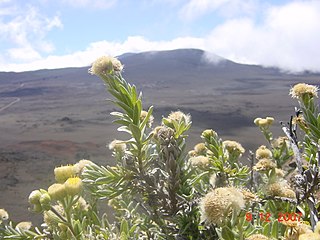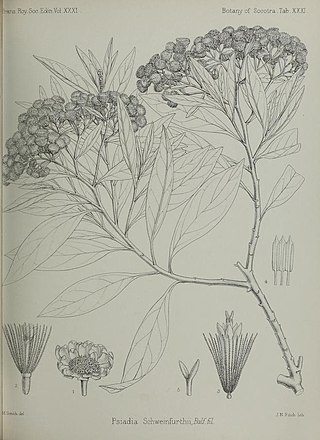
The redeye bass, redeye, or Coosa bass is a species of freshwater fish in the sunfish family (Centrarchidae) native to the Coosa River system of Georgia, Alabama. The waters it is normally found in are cool streams and rivers in the foothills of mountains.

The shoal bass is a species of freshwater fish in the sunfish family (Centrarchidae) of order Perciformes. One of the black basses, it is native to waters in Florida and Georgia. It is also occasionally found in rivers and streams of East Alabama where it has been declared an endangered species and cannot legally be kept if caught by fishermen. Of typical size for a black bass, M. cataractae reaches a maximum recorded length of 24 inches (61 cm) and a maximum published weight of 8 pounds, 12 ounces.

The longnose dace is a freshwater minnow native to North America. Rhinicthys means snout fish and cataractae means of the cataract. Longnose dace are small, typically less than 100 mm and characterized by their fleshy snout that protrudes past the mouth. They are well adapted for living on the bottom of fast-flowing streams among stones. Longnose dace eat algae and aquatic insects and are important forage minnows for larger predatory fish.

A least-concern species is a species that has been categorized by the International Union for Conservation of Nature (IUCN) as evaluated as not being a focus of species conservation because the specific species is still plentiful in the wild. They do not qualify as threatened, near threatened, or conservation dependent.
The southern brook lamprey is a lamprey found in the Southern United States including Arkansas, Louisiana, Mississippi, Alabama, and Georgia. It is a jawless fish with a sucking mouth on one end of it. It can appear to be a small eel, since it is rarely longer than one foot in length.
Barbodes cataractae is a species of cyprinid endemic to the Philippines where it is known from the Cascade River and the brackish waters of Murcielagos Bay in Mindanao. This species is commercially important.

Psiadia, commonly known as daisy trees, is a genus of mostly woody Asian and African plants in the tribe Astereae within the family Asteraceae. The genus is distributed throughout the Western Indian Ocean, with species reported from continental Eastern Africa, Madagascar, Mauritius, La Reunion, Rodrigues, the Comoro islands, as well as several of the smaller, uninhabited islands in the Mozambique Channel. Additional species are suspected on Socotra and Sri Lanka, but these have not been confirmed. Phylogenetic studies using DNA sequence data and biogeographic reconstruction using molecular dating have shown that the genus originated on the African mainland, and colonized Madagascar and the outlying islands in the Indian Ocean in several independent instances of overwater dispersal in the Miocene.

Psiadia schweinfurthii is an extinct species of flowering plant in the family Asteraceae. It was found only in Yemen.

Paragomphus is a genus of dragonfly in the family Gomphidae. They are commonly known as Hooktails.
Paragomphus cataractae is a species of dragonfly in the family Gomphidae. It is found in the Kunene River basin in parts of Namibia, Zambia and Zimbabwe. Its natural habitat is rivers. It is threatened by habitat loss.
Pilea cataractae is a species of plant in the family Urticaceae. It is endemic to Mauritius. Its natural habitat is subtropical or tropical dry forests.
The Nooksack dace is a small cyprinid fish occurring in streams in southern British Columbia and western Washington state. It has not yet been formally described taxonomically. It is considered a genetically distinct subspecies of longnose dace but may be a distinct species.

The World's 25 Most Endangered Primates is a list of highly endangered primate species selected and published by the International Union for Conservation of Nature (IUCN) Species Survival Commission (SSC) Primate Specialist Group (PSG), the International Primatological Society (IPS), Global Wildlife Conservation (GWC), and Bristol Zoological Society (BZS). The IUCN/SSC PSG worked with Conservation International (CI) to start the list in 2000, but in 2002, during the 19th Congress of the International Primatological Society, primatologists reviewed and debated the list, resulting in the 2002–2004 revision and the endorsement of the IPS. The publication was a joint project between the three conservation organizations until the 2012–2014 list when BZS was added as a publisher. The 2018–2020 list was the first time Conservation International was not among the publishers, replaced instead by GWC. The list has been revised every two years following the biannual Congress of the IPS. Starting with the 2004–2006 report, the title changed to "Primates in Peril: The World's 25 Most Endangered Primates". That same year, the list began to provide information about each species, including their conservation status and the threats they face in the wild. The species text is written in collaboration with experts from the field, with 60 people contributing to the 2006–2008 report and 85 people contributing to the 2008–2010 report. The 2004–2006 and 2006–2008 reports were published in the IUCN/SSC PSG journal Primate Conservation,, since then they have been published as independent publications.
Acrocercops hormista is a moth of the family Gracillariidae. It is known from India and Madagascar.
Burrowsia is a genus in the lichen family Caliciaceae. It is monospecific, containing the single crustose lichen Burrowsia cataractae. Both the species and the genus were described as new to science in 2020 by Alan Fryday and Ian Medeiros. Burrowsia cataractae is known from only a single location in Mpumalanga, South Africa.

The West Cornwall Bryophytes Site of Special Scientific Interest is a group of seven locations of former mining activity, that form a single SSSI and Important Plant Area in western Cornwall, England, United Kingdom. The site is noted for its biological characteristics and derives its name from the rare bryophyte species found there.
Mimandria cataractae is a moth of the family Geometridae first described by Louis Beethoven Prout in 1917. It is found in Kenya, South Africa and Zimbabwe.









